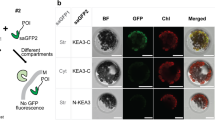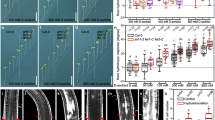Abstract
L-Tyrosine (Tyr) and its plant-derived natural products are essential in both plants and humans. In plants, Tyr is generally assumed to be synthesized in the plastids via arogenate dehydrogenase (TyrAa, also known also ADH), which is strictly inhibited by L-Tyr. Using phylogenetic and expression analyses, together with recombinant enzyme and endogenous activity assays, we identified prephenate dehydrogenases (TyrAps, also known as PDHs) from two legumes, Glycine max (soybean) and Medicago truncatula. The identified PDHs were phylogenetically distinct from canonical plant ADH enzymes, preferred prephenate to arogenate substrate, localized outside of the plastids and were not inhibited by L-Tyr. The results provide molecular evidence for the diversification of primary metabolic Tyr pathway via an alternative cytosolic PDH pathway in plants.
This is a preview of subscription content, access via your institution
Access options
Subscribe to this journal
Receive 12 print issues and online access
$259.00 per year
only $21.58 per issue
Buy this article
- Purchase on Springer Link
- Instant access to full article PDF
Prices may be subject to local taxes which are calculated during checkout





Similar content being viewed by others
References
Millner, P.A. & Barber, J. Plastoquinone as a mobile redox carrier in the photosynthetic membrane. FEBS Lett. 169, 1–6 (1984).
Strack, D., Vogt, T. & Schliemann, W. Recent advances in betalain research. Phytochemistry 62, 247–269 (2003).
Møller, B.L. Functional diversifications of cyanogenic glucosides. Curr. Opin. Plant Biol. 13, 338–347 (2010).
Kutchan, T.M. Alkaloid biosynthesis—the basis for metabolic engineering of medicinal plants. Plant Cell 7, 1059–1070 (1995).
Rösler, J., Krekel, F., Amrhein, N. & Schmid, J. Maize phenylalanine ammonia-lyase has tyrosine ammonia-lyase activity. Plant Physiol. 113, 175–179 (1997).
Higuchi, T., Ito, Y. & Kawamura, I. p-Hydroxyphenylpropane component of grass lignin and role of tyrosine-ammonia lyase in its formation. Phytochemistry 6, 875–881 (1967).
Bramley, P.M. et al. Vitamin E. J. Sci. Food Agric. 80, 913–938 (2000).
De Luca, V., Salim, V., Atsumi, S.M. & Yu, F. Mining the biodiversity of plants: a revolution in the making. Science 336, 1658–1661 (2012).
Tzin, V. & Galili, G. New insights into the shikimate and aromatic amino acids biosynthesis pathways in plants. Mol. Plant 3, 956–972 (2010).
Maeda, H. & Dudareva, N. The shikimate pathway and aromatic amino acid biosynthesis in plants. Annu. Rev. Plant Biol. 63, 73–105 (2012).
Siehl, D. in Plant Amino Acids: Biochemistry and Biotechnology (ed. Singh, B.) 171–204 (CRC Press, New York, 1999).
Rippert, P., Puyaubert, J., Grisollet, D., Derrier, L. & Matringe, M. Tyrosine and phenylalanine are synthesized within the plastids in Arabidopsis. Plant Physiol. 149, 1251–1260 (2009).
Rippert, P. & Matringe, M. Molecular and biochemical characterization of an Arabidopsis thaliana arogenate dehydrogenase with two highly similar and active protein domains. Plant Mol. Biol. 48, 361–368 (2002).
Rippert, P. & Matringe, M. Purification and kinetic analysis of the two recombinant arogenate dehydrogenase isoforms of Arabidopsis thaliana. Eur. J. Biochem. 269, 4753–4761 (2002).
Dal Cin, V. et al. Identification of genes in the phenylalanine metabolic pathway by ectopic expression of a MYB transcription factor in tomato fruit. Plant Cell 23, 2738–2753 (2011).
Connelly, J.A. & Conn, E.E. Tyrosine biosynthesis in Sorghum bicolor: isolation and regulatory properties of arogenate dehydrogenase. Z Naturforsch C 41, 69–78 (1986).
Gaines, C.G., Byng, G.S., Whitaker, R.J. & Jensen, R.A. l-Tyrosine regulation and biosynthesis via arogenate dehydrogenase in suspension-cultured cells of Nicotiana silvestris Speg. et Comes. Planta 156, 233–240 (1982).
Rubin, J.L. & Jensen, R.A. Enzymology of l-tyrosine biosynthesis in mung bean (Vigna radiata [L.] Wilczek). Plant Physiol. 64, 727–734 (1979).
Byng, G., Whitaker, R., Flick, C. & Jensen, R.A. Enzymology of l-tyrosine biosynthesis in corn (Zea mays). Phytochemistry 20, 1289–1292 (1981).
Hudson, G.S., Wong, V. & Davidson, B. Chorismate mutase/prephenate dehydrogenase from Escherichia coli K12: purification, characterization, and identification of a reactive cysteine. Biochemistry 23, 6240–6249 (1984).
Fischer, R. & Jensen, R.A. Prephenate dehydrogenase (monofunctional). Methods Enzymol. 142, 503–507 (1987).
Xia, T.H. & Jensen, R. A single clycohexadienyl dehydrogenase specifies the prephenate dehydrogenase and arogenate dehydrogenase components of the dual pathways to l-tyrosine in Pseudomonas aeruginosa. J. Biol. Chem. 265, 20033–20036 (1990).
Xu, S., Yang, Y., Jin, R., Zhang, M. & Wang, H. Purification and characterization of a functionally active Mycobacterium tuberculosis prephenate dehydrogenase. Protein Expr. Purif. 49, 151–158 (2006).
Maeda, H. et al. RNAi suppression of arogenate dehydratase1 reveals that phenylalanine is synthesized predominantly via the arogenate pathway in Petunia petals. Plant Cell 22, 832–849 (2010).
Secor, J. Inhibition of barnyardgrass 4-hydroxyphenylpyruvate dioxygenase by sulcotrione. Plant Physiol. 106, 1429–1433 (1994).
Bonvin, J., Aponte, R. & Marcantonio, M. Biochemical characterization of prephenate dehydrogenase from the hyperthermophilic bacterium Aquifex aeolicus. Protein Sci. 15, 1417–1432 (2006).
Maeda, H., Yoo, H. & Dudareva, N. Prephenate aminotransferase directs plant phenylalanine biosynthesis via arogenate. Nat. Chem. Biol. 7, 19–21 (2011).
Corea, O.R., Bedgar, D.L., Davin, L.B. & Lewis, N.G. The arogenate dehydratase gene family: towards understanding differential regulation of carbon flux through phenylalanine into primary versus secondary metabolic pathways. Phytochemistry 82, 22–37 (2012).
Bickel, H., Palme, L. & Schultz, G. Incorporation of shikimate and other precursors into aromatic amino acids and prenylquinones of isolated spinach chloroplasts. Phytochemistry 17, 119–124 (1978).
Westfall, C.S., Xu, A. & Jez, J.M. Structural evolution of differential amino acid effector regulation in plant chorismate mutases. J. Biol. Chem. 289, 28619–28628 (2014).
Colquhoun, T.A. et al. A petunia chorismate mutase specialized for the production of floral volatiles. Plant J. 61, 145–155 (2010).
Eberhard, J. et al. Cytosolic and plastidic chorismate mutase isozymes from Arabidopsis thaliana: molecular characterization and enzymatic properties. Plant J. 10, 815–821 (1996).
d'Amato, T.A., Ganson, R.J., Gaines, C. & Jensen, R. Subcellular localization of chorismate-mutase isoenzymes in protoplasts from mesophyll and suspension-cultured cells of Nicotiana silvestris. Planta 162, 104–108 (1984).
Prabhakar, V. et al. Phosphoenolpyruvate provision to plastids is essential for gametophyte and sporophyte development in Arabidopsis thaliana. Plant Cell 22, 2594–2617 (2010).
Lütke-Eversloh, T. & Stephanopoulos, G. Feedback inhibition of chorismate mutase/prephenate dehydrogenase (TyrA) of Escherichia coli: generation and characterization of tyrosine-insensitive mutants. Appl. Environ. Microbiol. 71, 7224–7228 (2005).
Sun, W. et al. The crystal structure of Aquifex aeolicus prephenate dehydrogenase reveals the mode of tyrosine inhibition. J. Biol. Chem. 284, 13223–13232 (2009).
Chiu, H.J. et al. The structure of Haemophilus influenzae prephenate dehydrogenase suggests unique features of bifunctional TyrA enzymes. Acta Crystallogr. Sect. F Struct. Biol. Cryst. Commun. 66, 1317–1325 (2010).
Sun, W., Singh, S., Zhang, R., Turnbull, J. & Christendat, D. Crystal structure of prephenate dehydrogenase from Aquifex aeolicus insights into the catalytic mechanism. J. Biol. Chem. 281, 12919–12928 (2006).
Legrand, P. et al. Biochemical characterization and crystal structure of Synechocystis arogenate dehydrogenase provide insights into catalytic reaction. Structure 14, 767–776 (2006).
Christendat, D., Saridakis, V. & Turnbull, J. Use of site-directed mutagenesis to identify residues specific for each reaction catalyzed by chorismate mutase-prephenate dehydrogenase from Escherichia coli. Biochemistry 37, 15703–15712 (1998).
Turnbull, J., Morrison, J.F. & Cleland, W. Kinetic studies on chorismate mutase-prephenate dehydrogenase from Escherichia coli: models for the feedback inhibition of prephenate dehydrogenase by l-tyrosine. Biochemistry 30, 7783–7788 (1991).
Riewe, D. et al. A tyrosine aminotransferase involved in tocopherol synthesis in Arabidopsis. Plant J. 71, 850–859 (2012).
Lee, E.-J. & Facchini, P.J. Tyrosine aminotransferase contributes to benzylisoquinoline alkaloid biosynthesis in opium poppy. Plant Physiol. 157, 1067–1078 (2011).
Yoo, H. et al. An alternative pathway contributes to phenylalanine biosynthesis in plants via a cytosolic tyrosine:phenylpyruvate aminotransferase. Nat. Commun. 4, 2833 (2013).
Bonawitz, N.D. & Chapple, C. The genetics of lignin biosynthesis: connecting genotype to phenotype. Annu. Rev. Genet. 44, 337–363 (2010).
Weng, J.-K., Philippe, R.N. & Noel, J.P. The rise of chemodiversity in plants. Science 336, 1667–1670 (2012).
Pichersky, E. & Lewinsohn, E. Convergent evolution in plant specialized metabolism. Annu. Rev. Plant Biol. 62, 549–566 (2011).
Karunanandaa, B. et al. Metabolically engineered oilseed crops with enhanced seed tocopherol. Metab. Eng. 7, 384–400 (2005).
Rippert, P., Scimemi, C., Dubald, M. & Matringe, M. Engineering plant shikimate pathway for production of tocotrienol and improving herbicide resistance. Plant Physiol. 134, 92–100 (2004).
Zhang, C. et al. Genetic and biochemical basis for alternative routes of tocotrienol biosynthesis for enhanced vitamin E antioxidant production. Plant J. 73, 628–639 (2013).
Edgar, R.C. MUSCLE: multiple sequence alignment with high accuracy and high throughput. Nucleic Acids Res. 32, 1792–1797 (2004).
Whelan, S. & Goldman, N. A general empirical model of protein evolution derived from multiple protein families using a maximum-likelihood approach. Mol. Biol. Evol. 18, 691–699 (2001).
Saitou, N. & Nei, M. The neighbor-joining method: a new method for reconstructing phylogenetic trees. Mol. Biol. Evol. 4, 406–425 (1987).
Gilchrist, D. & Connelly, J. Chorismate mutase from mung bean and sorghum. Methods Enzymol. 142, 450–463 (1987).
Schuller, K.A., Plaxton, W.C. & Turpin, D.H. Regulation of phosphoenolpyruvate carboxylase from the green alga Selenastrum minutum. Plant Physiol. 93, 1303–1311 (1990).
Kang, F. & Rawsthorne, S. Starch and fatty acid synthesis in plastids from developing embryos of oilseed rape (Brassica napus L.). Plant J. 6, 795–805 (1994).
Bionda, T. et al. Chloroplast import signals: the length requirement for translocation in vitro and in vivo. J. Mol. Biol. 402, 510–523 (2010).
Wu, F.-H. et al. Tape-Arabidopsis Sandwich—a simpler Arabidopsis protoplast isolation method. Plant Methods 5, 5–16 (2009).
Yoo, S.-D., Cho, Y.-H. & Sheen, J. Arabidopsis mesophyll protoplasts: a versatile cell system for transient gene expression analysis. Nat. Protoc. 2, 1565–5172 (2007).
Hajdukiewicz, P., Svab, Z. & Maliga, P. The small, versatile pPZP family of Agrobacterium binary vectors for plant transformation. Plant Mol. Biol. 25, 989–994 (1994).
Acknowledgements
We thank R. Singhal (University of Wisconsin) for help with protoplast isolation; S. Swanson, A. Chanoca and R. Buono (University of Wisconsin) for assistance with confocal imaging and analysis; C. Grau (University of Wisconsin) for soybean Williams82 seeds; J.-M. Ané (University of Wisconsin) for M. truncatula tissues and seeds; and F.R. Márquez (Universidad Andrés Bello) for the 35S-pPZP211 vector. The confocal imaging was performed at the Newcomb Imaging Center, Department of Botany, University of Wisconsin-Madison. This work was supported by grant IOS-1354971 from the US National Science Foundation to H.A.M., the Fritz Went Undergraduate Fellowship to S.C. and the start-up funds from the Graduate School, the College of Letters & Science, and the Department of Botany, University of Wisconsin-Madison to H.A.M.
Author information
Authors and Affiliations
Contributions
C.A.S. and H.A.M. designed research, and C.A.S. performed phylogenetic analyses, enzyme purification and characterization, localization studies and inhibition assays. S.C. performed gene expression analyses, enzyme purification and enzymatic assays. D.L.S. performed chromatographic separations and enzymatic assays, and H.A.M. performed localization studies and enzymatic assays. C.A.S., S.C., D.L.S. and H.A.M. analyzed data, C.A.S. and H.A.M. wrote the manuscript. All authors read and edited the manuscript.
Corresponding author
Ethics declarations
Competing interests
The authors declare no competing financial interests.
Supplementary information
Supplementary Text and Figures
Supplementary Results, Supplementary Tables 1–3 and Supplementary Figures 1–13. (PDF 3957 kb)
Rights and permissions
About this article
Cite this article
Schenck, C., Chen, S., Siehl, D. et al. Non-plastidic, tyrosine-insensitive prephenate dehydrogenases from legumes. Nat Chem Biol 11, 52–57 (2015). https://doi.org/10.1038/nchembio.1693
Received:
Accepted:
Published:
Issue Date:
DOI: https://doi.org/10.1038/nchembio.1693
This article is cited by
-
Coordinated regulation of the entry and exit steps of aromatic amino acid biosynthesis supports the dual lignin pathway in grasses
Nature Communications (2023)
-
Using interdisciplinary, phylogeny-guided approaches to understand the evolution of plant metabolism
Plant Molecular Biology (2022)
-
Identification and biochemical characterisation of tyrosine aminotransferase from Anthoceros agrestis unveils the conceivable entry point into rosmarinic acid biosynthesis in hornworts
Planta (2021)
-
General and specialized tyrosine metabolism pathways in plants
aBIOTECH (2020)
-
Completion of the cytosolic post-chorismate phenylalanine biosynthetic pathway in plants
Nature Communications (2019)



